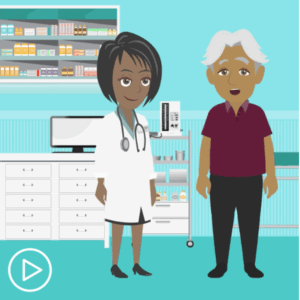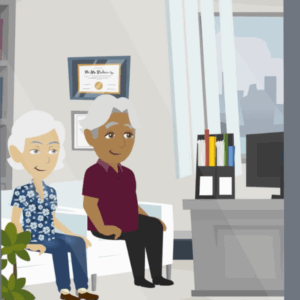What is watch and wait and how is it used to manage chronic lymphocytic leukemia (CLL)? This animated video explains this approach to CLL care, discusses how patients are monitored, and reviews signs that indicate it may be time to move forward with treatment.
Related Resources
Transcript
Joseph:
Hi! I’m Joseph. I’m a CLL patient advocate, and this is my doctor, Dr. Johnson. When I was first diagnosed with CLL, my care team suggested an approach called “watch and wait,” which meant that even though I had CLL, I didn’t need treatment yet.
At first, it made me feel anxious to be diagnosed with a blood cancer but to not treat the disease right away, but Dr. Johnson explained that CLL therapy doesn’t always start when a patient is first diagnosed. Can you please share more about this, Dr. Johnson?
Dr. Johnson,
Absolutely—the watch-and-wait phase may also be called “active surveillance.” It’s a safe and common approach for many people with early-stage, low risk or asymptomatic CLL.
During this time, your healthcare team keeps an eye on the disease to watch for signs that it is progressing. I want to point out that you’re not being ignored, you’re being closely watched and monitored for changes.
And the goal of this approach is to start treatment if and when the CLL begins to cause problems so that patients don’t have to experience unnecessary side effects. It’s been shown in research studies that no harm comes from the watch-and-wait approach when compared to treating early-stage CLL immediately.1 And, in fact, some patients with CLL may never need therapy.
Joseph:
Right—and in my case, I didn’t need treatment right away because my disease hadn’t progressed, and I wasn’t experiencing any symptoms.
And even though it helps to understand WHY you might be put in watch and wait, it can still be an uncertain time. Many patients benefit from meeting with a counselor or social worker to help them work through it—I know I did!
Dr. Johnson:
Excellent point, Joseph. Your mental health is just as important as your physical health.
Joseph:
Joseph:
And it helped me that I met with you regularly. Dr. Johnson, can you explain how patients are monitored throughout watch and wait?
Dr. Johnson:
I would be happy to. Patients meet with their care team often to check in on their health and to assess their symptoms. These visits can include:
- Checking the size of lymph nodes and the spleen to see if they are enlarged.
- Blood work to find out if the disease is beginning to progress.
- And your doctor may also order imaging tests like a CT scan or an ultrasound.
Joseph:
I was in watch in wait for several years. And, at first, I was a little restless. But I used that time to get to know my CLL care team, to learn more about my disease, and to find the emotional support I needed. When it was time to move forward with therapy, I felt confident and well-informed.
Dr. Johnson:
Exactly. When CLL symptoms begin to appear, such as fatigue, night sweats, unexplained weight loss and/or fevers, it could indicate it’s time to start treatment.
Other reasons to start therapy may include:
- An increase in CLL cell numbers.
- A decrease in red blood cells and or platelet numbers.
- Or a change in the size of lymph nodes, spleen and/or liver.
Joseph:
That’s good information to have, Dr. Johnson. Once the symptoms of my CLL started to impact my daily life, you and I discussed my options and decided on a treatment plan that was best for me.
Remember—watch and wait doesn’t have to be watch and worry—stay in close contact with your care team and get the support you need.
Thanks for joining us! Download the guide that goes with this video to review what we covered.
Visit powerfulpatients.org/CLL to access more CLL information.



